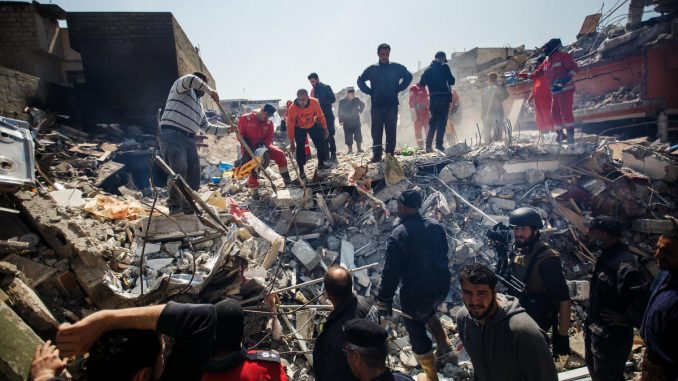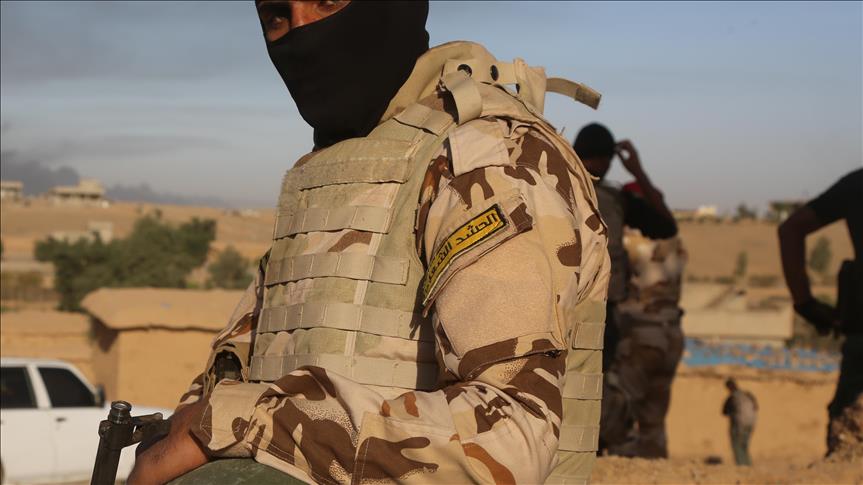
The military operations in Mosul against ISIS caused more than 300.000 to flee the city, who were gravely affected by the war and escaped death that became a daily habit on both ISIS’ and the US coalition hands.
At the height of its power two years ago, Islamic State ruled over millions of people in territory running from northern Syria through towns and villages along the Tigris and Euphrates river valleys to the outskirts of Baghdad in Iraq.
However, ISIS’s territory is shrinking rapidly since last year as the US-led coalition, the Turkish-backed forces, and the Russian-backed Assad regime forces have fierce fights against its forces in both Syria and Iraq.
The United States is providing air and ground support to Iraqi and Kurdish forces trying to dislodge the hardline group from Mosul.
Iraqi forces captured the eastern side of Mosul in January after 100 days of fighting and launched their attack on the districts that lie west of the Tigris river on Feb. 19.
Islamic State militants retreated across the Tigris river to western districts of Mosul, where they are using mortars, sniper fire, booby traps and suicide car bombs to fight the offensive carried out by a 100,000-strong force made up of Iraqi armed forces, regional Kurdish peshmerga fighters, and Iranian-trained Shi’ite paramilitary groups.
ISIS militants had grave losses in western Mosul despite their fierce resistance and were not able to advance rapidly despite using extreme force and fire power.
This battle had a grave effect on the civilians in Mosul, as more than 320,000 civilians have been displaced since the military operations started, and were accommodated in refugee camps that are crumbling by the newcomers and lack the basic living conditions.
The civilians escaped death and suffer that increased since the military operations started, as thousands of civilians have been killed and injured by both ISIS and the US coalition.
Since October 2016, when the Mosul campaign began, more than 6,000 wounded – over half of them civilians – have been sent to hospitals in Erbil and liberated eastern Mosul, as well as to field hospitals around the city. In one incident, more than 200 civilians were killed in an alleged US airstrike on west Mosul.
Civilians vulnerable to airstrikes
Civilians in west Mosul remain vulnerable to airstrikes one month after at least 130 were killed in a likely coalition airstrike, the Iraqi Observatory for Human Rights has reported, documenting the deaths of tens of people in reported airstrikes during the past week.
The Observatory claimed the coalition is most likely responsible for deadly airstrikes and that it has not altered its tactics after the deadly incident of March 17, despite close international scrutiny.
“The Observatory confirmed that the international coalition continues to use the same techniques that led to the death of hundreds of civilians previously without any observed changes to protect west Mosul civilians from their fires, which in fact must be aimed at ISIS,” reads a report published by the Observatory on Sunday.
The Observatory documented the deaths of tens of people, including entire families, in several airstrikes between April 10 and 15 based on reports from eyewitnesses.
Five families, numbering about 30 people in total, were killed on April 10 when an airstrike destroyed their house near the Yarmouk bridge. The house was hit about an hour after an ISIS militant had left the roof of the house, a family member of the deceased told the Observatory.
Three generations of one family of 42 people gathered in a house in the Bab Sinjar area were killed on April 15 in a reported airstrike.
On the same day, another house in the Islah area was completely destroyed. An eyewitness whose son was injured in the incident told the Observatory, “ISIS fighters launched a drone from my son’s house and ran. This was followed by two missiles targeting the house and resulted in the death of 8 civilians. So far their bodies still remain under the rubble.”
The Observatory stated that it urges all parties to the conflict to abide by international human rights law and give priority to protecting civilians. “It also demands the international coalition and the intelligence entities responsible for detecting ISIS targets on ground to be more precise and cautious to avoid any harm to civilians.”
A likely coalition airstrike killed at least 130 people in west Mosul on March 17. The coalition and Iraqi forces are carrying out an investigation of the incident, but coalition officials have admitted one of their strikes likely played a role in the deaths of the civilians who appear to have been in one house by ISIS as human shields.
Coalition spokesperson Col. John Dorrian told reporters this week that ISIS has “intensified their efforts to bring civilians into harm’s way. This is something that is a despicable and cowardly tactic.”
He declined to get into specifics of the ongoing investigation but said “I know that there’s been some lab work conducted to try and, you know, look at some samples of various substances that were found around the sites. There had been engineers and experts brought in. There have been a lot of witnesses interviewed,” in order to put together a comprehensive picture of what happened.
Read more: Mosul’s operations have a huge toll on the civilians’ lives and health
Who knows who is shooting?
Inside the hospital, most of the victims – half of whom are women and children – were wounded due to the fighting in Mosul. “Who knows who was shooting? We were in the middle of the fighting and we couldn’t go out for six days,” said Chad, a 19-year-old woman whose leg was injured in a mortar strike in Mosul’s Wadi Hajjar district.
“There was a sniper on the rooftop of our house and then a mortar hit us. I lost my brother. I don’t remember much,” she said as she waited to undergo an operation on her leg.
For those like Chad, the lines separating the “good guys” from the “bad guys” are fading away. The human cost of the campaign to take Mosul has increased since Iraqi forces advised civilians to stay in their homes. The reason: the Iraqi military wants to limit the amount of human displacement as it tries to push ISIS out of the city. Despite its calls, though, 200,000 people have fled since the start of the operation to retake the western half of Mosul. With government forces bogged down in vicious street-to-street fighting, ISIS has sought to exploit the strategy of “civilian protection”.
“Civilians are being manipulated [by ISIS] to slow down the military operation,” said Michela Paschetto, a nurse and medical coordinator for Emergency, an Italian NGO that runs the Erbil hospital. “Families are being taken by ISIS to fill the buildings where [their units] are hiding and they use them as human shields.”
Desperate medical conditions
The harsh military operations and the use of extreme firepower had a huge toll on the civilians’ lives as many civilians were seriously injured or lost parts of their bodies to be handicapped for the rest of their lives.
Due to the difficulty in escaping from areas where heavy fighting is taking place, thousands of wounded civilians have been unable to access timely medical care – leading to an increase in the number of amputated limbs.
Lying in a hospital bed, Iraqi student Ahmed Khalaf is close to despair after having lost a leg when rocket shrapnel hit him as he ran for his life from Islamic State (ISIS) militants in Mosul.
“Be strong, Ahmed, and have no fear,” psychotherapist Karam Saad advises the 20-year-old Khalaf as he relates how his family had just set out from home to escape western Mosul’s war zone three weeks ago, only for the rocket to crash nearby.
Khalaf is in now in a hospital south of Mosul but has lost contact with his father and brother, who were seriously wounded in the March 19 incident. The father and brother are in intensive care in different clinics in Erbil in the relatively peaceful Kurdish autonomous region 80 km (50 miles) from Mosul.
Khalaf is struggling to come to terms with the fact doctors had to amputate his right leg above the knee. He was offered trauma support, something unusual in deeply conservative and religious Iraq, to help him cope with his new disability.
“The psychological sessions have helped me but these thoughts keep coming back about what has happened to me, to my father and brother. They keep coming and coming,” Khalaf tells the psychotherapist.
“I can’t think of my future right now. But, God willing, I can resume my life, continue my school studies.”
The humanitarian group Handicap International has given counseling to Khalaf and more than 5,300 other displaced people from Mosul. It has also provided physical rehabilitation to almost 1,200 badly wounded people including amputees.
humanitarian organizations are struggling
However, with the battle entering its seventh month and around 400,000 civilians still trapped in the militants’ fiercely defended last urban bastion in Iraq – Mosul’s labyrinthine Old City, this is just the start.
“Facing a crisis of such scale, the humanitarian organizations may have difficulties in responding to all the needs,” said Marlene Sigonney, the group’s spokeswoman.
The idea of psychotherapy is relatively new in Iraq, whereas in other conservative Arab countries people with emotional problems tend to seek help in a mosque or church, not a clinic.
“In Iraqi society, people are reluctant to deal with psychological issues,” said Saad, who graduated from Mosul University before Islamic State overran the city. “They accept treatment only for the worst mental cases.”
Apart from suffering from trauma, Iraqis who have lost legs or arms in war zones also struggle to get artificial limbs. At a specialist center run by the International Committee of the Red Cross in Erbil, patients must wait two months for treatment.
The Erbil clinic is trying to recruit more specialists to help cope with an overflow of 210 cases from war-torn Nineveh province, of which Mosul is the regional capital.
One of those learning to walk again is Ahmed Ammar, a car mechanic, and father of five who ran a garage in western Mosul.
“I opened the yard door and an IED (improvised explosive device) exploded,” he said as he practiced with his new prosthetic leg at the Erbil hospital.
“They cut off my leg from the ankle and fitted a prosthetic leg but then I got gangrene and they cut off my leg further from the knee (down). Islamic State planted the device. They took my leg.”
The end of the battle for Mosul will also leave Iraq struggling with thorny political issues including control of recaptured territory in the north that is claimed by both the country’s autonomous Kurdish region and its federal government.
And Iraq will still be contending with the effects of the war — citizens killed, wounded or missing, hundreds of thousands displaced, houses, shops, and infrastructure wrecked, children years behind in school — for years to come.



